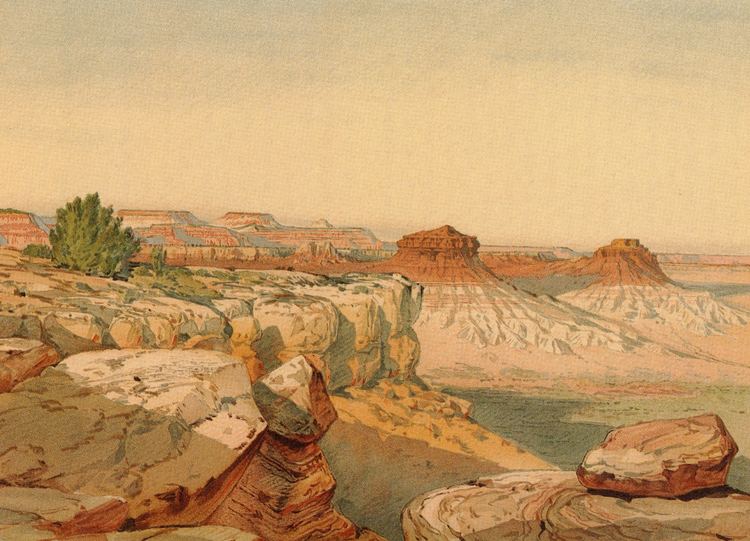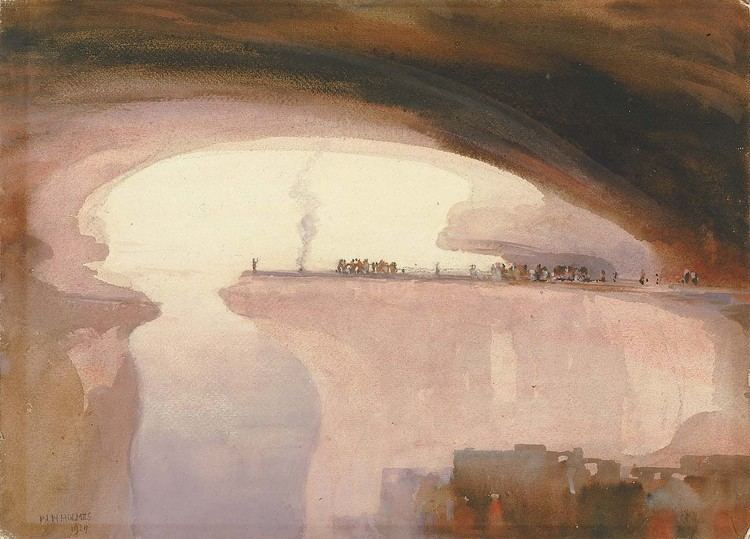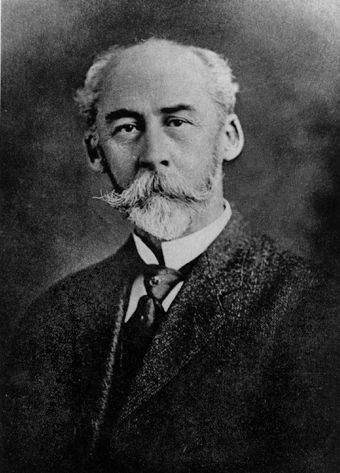Nationality American Role Anthropologist | Name William Holmes Spouse Kate Holmes | |
 | ||
Known for Scientific Illustration of the American West; Role in Controversy over the Antiquity of Man in the Americas Fields Anthropology, Archaeology, Art, Cartography, Curator, Geology Books Pottery of the ancient Pueblos, Hopi Pottery Symbols, Polar Whaling: A Sea Lette, A Study of The Textile Art In Its, Origin and Development of Form a Similar People William Henry Jackson, George Amos Dorsey, Robert Dunnell | ||
William henry holmes
William Henry Holmes (December 1, 1846 – April 20, 1933) — known as W.H. Holmes — was an American explorer, anthropologist, archaeologist, artist, scientific illustrator, cartographer, mountain climber, geologist and museum curator and director.
Contents
- William henry holmes
- The Art of William Henry Holmes Facebook Live Broadcast
- Early life and education
- Hayden Survey
- Dutton Survey
- Smithsonian Institution
- Later years
- Art
- Legacy
- Selected Writings
- References

The Art of William Henry Holmes (Facebook Live Broadcast)
Early life and education

William Henry Holmes was born on a farm near Cadiz, in Harrison County, Ohio, to Joseph and Mary Heberling Holmes on December 1, 1846. One of his forebears was the Rev. Obadiah Holmes, who emigrated to Salem, Massachusetts in 1638. William Henry Holmes graduated from the McNeely Normal School, Hopedale, Ohio in 1870 and afterwards briefly taught drawing, painting, natural history, and geology at the School. In 1889 the school awarded him an honorary A.B. (Bachelor of Arts) degree. Later, in 1918, Holmes received an honorary Doctor of Science degree from The George Washington University, Washington, D.C. for his work and achievements.
Hayden Survey

In 1871, he went to Washington, D.C., to study art under Theodore Kaufmann. His talent soon came to the attention of the scientists at the Smithsonian Institution, notably Fielding Bradford Meek, and Holmes was employed drawing and sketching fossil shells and shells of live mollusks. In 1872, Holmes became an artist/topographer with the government survey of Ferdinand Vandeveer Hayden, replacing Thomas Moran. His first trip out West was to the newly established Yellowstone National Park. During the 1870s, Holmes gained a national reputation as a scientific illustrator, cartographer, pioneering archaeologist, and geologist. His work on the laccolith influenced Grove Karl Gilbert's own work on the same. In the field, Holmes worked closely with the photographer William H. Jackson and back in Washington he helped produce Hayden's great achievement, the Geological and Geographical Atlas of Colorado, And Portions of Adjacent Territory (1877, 1881).
Dutton Survey

After the Hayden Survey was absorbed into the U.S. Geological Survey in 1879, Holmes went to Munich, Germany, to further his art studies under Frank Duveneck and to take lessons in "museum making" from Adolphe B. Meyer of Dresden's Anthropology Museum. On Holmes's return to the U.S., he was hired by the Geological Survey and assigned to Clarence Dutton as a geologist and illustrator. Holmes illustrated the atlas for Dutton's Tertiary History of the Grand Canyon District (1882); his triptych panorama of the Grand Canyon from Point Sublime is a masterpiece of American scientific illustration. He was also a noted mountain climber, and a peak in Yellowstone National Park — Mount Holmes — was named in his honor. In 1875, Holmes began studying the remains of the Ancestral Pueblo culture in the San Juan River region of Utah. His models of ancient Indian ruins were a sensation at the Centennial International Exhibition in Philadelphia. Holmes became particularly interested in prehistoric pottery and shell art, producing the published works of "Art in Shell of the American Indians (1883)" and "Pottery of the Ancient Pueblos (1886)". He expanded these studies to include textiles, and he became well known as an expert in both ancient and existing arts produced by Native Americans of the Southwest. In 1889 he discovered and reported Indian petroglyphs in central West Virginia.
Smithsonian Institution

Holmes left the Geological Survey in 1889 to become an archaeologist with the Smithsonian Institution's Bureau of American Ethnology. He left Washington temporarily, from 1894 to 1897, to serve as curator of anthropology at the Field Columbian Museum in Chicago. He returned to the Smithsonian in 1897 to serve as head curator of anthropology at the U.S. National Museum. From 1902 to 1909 he served as Chief (i.e. director) of the Bureau of American Ethnology, succeeding John Wesley Powell. During this period he studied the Etowah Indian Mounds of the Mississippian culture in Georgia, and in 1903, he published his Synthesis of Pottery. In 1905, Holmes was elected a member of the American Antiquarian Society. In 1910, he became chairman of the Division of Anthropology of the U.S. National Museum. In 1920, Holmes became the director of National Gallery of Art (now the Smithsonian American Art Museum), where he assembled exhibits of Indian arts from the Northwest Coast. He published many works on archæological and anthropological subjects. He edited geological publications, including Hayden's Atlas of Colorado and the eleventh and twelfth reports of the Geological Survey. His books include: "Handbook of Aboriginal American Antiquities" (1919).
Later years
Holmes lived with his son in Royal Oak, Michigan, upon his retirement in 1932 from the position of Director of the National Gallery of Art. He died April 20, 1933.
Art
In the year of his death, a memorial exhibition of ninety-two of Holmes' artwork was held at the Corcoran Gallery of Art.
Legacy
Of Holmes's many contributions and accomplishments, he is probably best known for the role he played in the controversy over the antiquity of humans in the Americas. Holmes insisted that claims for the early presence of humans should be subjected to the most rigorous testing. His position on this matter had a healthy and conservative influence on what is one of the most fundamental questions in American archaeology.
Selected Writings
Published and unpublished writings by Holmes include:
